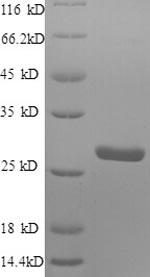Enhance your cardiovascular research with our premium-quality Recombinant Human S100A4 protein, also known as Calvasculin, Metastasin, Placental calcium-binding protein, Protein Mts1, and S100 calcium-binding protein A4. S100A4 is involved in a variety of cellular processes, including motility, proliferation, and angiogenesis, and plays a significant role in the progression of atherosclerosis and other cardiovascular diseases, making it an important target for research and therapeutic intervention.
Our Recombinant Human S100A4 protein is produced using a reliable E.coli expression system, ensuring a consistent and high-quality source for your research needs. The full-length mature protein sequence (2-101aa) is N-terminal 6xHis-SUMO-tagged to facilitate efficient purification while maintaining native conformation and activity. With a purity greater than 90% as determined by SDS-PAGE, our S100A4 protein guarantees dependable and reproducible results in various experimental setups. Choose between liquid and lyophilized powder forms to best suit your research requirements, and take advantage of our exceptional-quality Recombinant Human S100A4 protein in your cardiovascular research.






